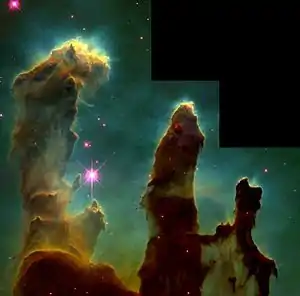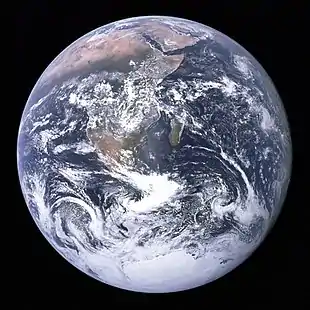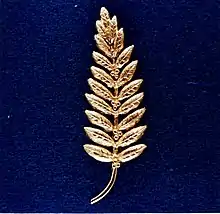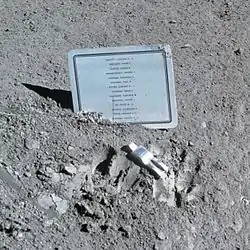Space art
"Space art" (also "astronomical art") is the term for a genre of modern artistic expression that strives to show the wonders of the Universe. Like other genres, Space Art has many facets and encompasses realism, impressionism, hardware art, sculpture, abstract imagery, even zoological art. Though artists have been making art with astronomical elements for a long time, the genre of Space Art itself is still in its infancy, having begun only when humanity gained the ability to look off our world and artistically depicted what we see out there. Whatever the stylistic path, the artist is generally attempting to communicate ideas somehow related to space, often including an appreciation of the infinite variety and vastness which surrounds us. In some cases, artists who consider themselves Space Artists use more than illustration and painting to communicate scientific discoveries or works depicting space, some have had the opportunity to work directly with space flight technology and scientists in attempts to expand the arts, humanities, and cultural expression relative to space exploration.

Practitioners of the visual arts have for many decades explored space in their imaginations using traditional painting media and many are now using digital media toward similar ends. Science fiction magazines and picture essay magazines were once a major outlet for Space Art, often featuring planets, space ships and dramatic alien landscapes. Chesley Bonestell, R. A. Smith, Lucien Rudaux, David A. Hardy and Ludek Pesek were some of the major artists in the early days of the genre actively involved in visualizing space exploration proposals with input from astronomers and experts in the infant rocketry field anxious to spread their ideas to a wider audience. (Indeed, NASA's second administrator, James E. Webb, initiated the space agency's Space Art program in 1962, four years after its founding.)[1] A strength of Bonestell's work in particular was the portrayal of exotic worlds with their own alien beauty, often giving a sense of destination as much as of the technological means of getting there.
International Association of Astronomical Artists
The premier organization and only guild in the world dedicated to the creation of Space Art is the International Association of Astronomical Artists (IAAA). Composed of over 120 members, artists of the IAAA depict the wonders of the Universe in ways to inspire the greater human population and raise awareness of space. Members of the IAAA have been creating Space Art in all of its myriad forms since its founding in 1982, from traditional painting to digital works to 3-D zero-gravity sculpture. Numerous book and magazine covers, movie effects, or artistic images illustrating the newest astronomical discoveries are done by an IAAA member.
Photography

The cosmos contains many sources of visual inspiration that our growing abilities to gather and propagate has spread through the mass culture. The first photographs of the entire Earth by satellites[2] and manned Apollo missions[3] brought a new sense of our world as an island in empty space and promoted ideas of the essential unity of Humanity.[4] Photographs taken by explorers on the Moon shared the experience of being on another world. The famous Pillars of Creation[5] Hubble Space Telescope and other Hubble photos often evoke intense responses from viewers, for example Hubble's planetary nebula images.[6]
Artistry
Space artists may work closely with space scientists and engineers to help them to visualize and develop their scientific and technological concepts of making the dream of space exploration a reality. Other forms of pictorial Space Art bring the viewer to inner visions inspired directly or otherwise by the fruits of the expanding vision of Humanity. Some aspects of such art pay visual homage to outer space, popular ideas of life on other worlds including alien visitation visions, dream symbology, psychedelic imagery and other influences on contemporary visionary art.
Now that artists have experienced free-fall conditions during flights flown with NASA, the Russian and French Space Agencies, and with the Zero Gravity Arts Consortium, new methods of artistic expressions unknowable today will unfold as artists imagine new ways to utilize microgravity environments to create artistic works. Although such dreams await substantial opportunity, early efforts by artists to have art pieces placed in space have already been accomplished with painting, holography, microgravity mobiles, floating literary works, and sculpture.[7]
Art in space

The first active artist in space was Alexei Leonov, producing for example the first drawing in space onboard Voskhod 2 in 1965, depicting a sunrise.
First original oil paintings flown in outer space
An art conservation experiment from Vertical Horizons,[8] founded by Howard Wishnow and Ellery Kurtz, was flown aboard the Space Shuttle Columbia STS-61-C January 12, 1986. Four original oil paintings by American artist Ellery Kurtz were flown in one of NASA's Get Away Special (G.A.S.) container mounted to a bridge in the shuttle cargo bay. These original works of art are the first oil paintings to enter Earth's orbit. This NASA GAS canister, designated G-481, was the 46th such canister flown aboard a Space Shuttle. The Space Shuttle Columbia orbited the Earth 98 times during its mission duration time of 6 days, 2 hours, 3 minutes and 51 seconds. Columbia was launched from Kennedy Space Center, Cape Canaveral, Florida, on January 12, 1986 and landed at the Kennedy Space Center on January 18, 1986.
Zero-g space art
Another work, later brought to Earth-orbit sometime in the mid-80s, was a radiant study of the golden sunlight on a Soviet space station by Russian artist Andrei Sokolov, carried aboard the Soviet Mir space station starting with modules in February 1986. In 1984 Joseph McShane and in 1989 Lowry Burgess had their conceptual artworks flown aboard the Space Shuttle utilizing NASA's 'Get Away Special' program.[9] The first sculpture specifically designed for a human habitat in orbit was Arthur Woods' Cosmic Dancer[10][11] which was sent to the Mir station in 1993. In 1995, Arthur Woods organized Ars ad Astra - the 1st Art Exhibition in Earth orbit[12] consisting of 20 original artworks from 20 artists and an electronic archive also took place on the Mir space station as a part of ESA's EUROMIR'95 mission. In 1998, Frank Pietronigro flew Research Project Number 33: Investigating The Creative Process in a Microgravity Environment where the artist drew, created 'drift paintings' and danced in microgravity space. In 2006, the artist returned to microgravity flight to create three new works, one in collaboration with Lowry Burgess, Moments in the Infinite Absolute, Flags in Space! and a new form of microgravity mobile.
The Slovenian theater director Dragan Živadinov staged a performance called Noordung Zero Gravity Biomechanical during a parabolic flight organized through the Yuri Gagarin Cosmonaut Training Center facility in Star City in 1999. The UK arts group The Arts Catalyst, with the MIR consortium (Arts Catalyst, Projekt Atol, V2_Organisation, Leonardo-Olats) organised a series of parabolic 'zero gravity' flights for artistic and cultural experimentation with the Gagarin Cosmonaut Training Centre, as well as with the European Space Agency, between 2000 and 2004, including Investigations in Microgravity,[13] MIR Flight 001,[14] and MIR Campaign 2003.[15][16][17][18] Artists who participated in these flights and visits to Russia and ESA have included the Otolith Group, shortlisted in 2011 for the Turner Prize, Stefan Gec, Ansuman Biswas and Jem Finer, Kitsou Dubois, Yuri Leiderman, and Marcel.li Antunez Roca.
The Mexican artist and musician Nahum directed the art and science project Matters of Gravity (La Gravedad de los Asuntos in Spanish), a project reflecting on gravity by its absence. The first mission consisting only of Latin American artists was executed in a zero gravity flight at the Yuri Gagarin Cosmonaut Training Centre in 2014. The participating artists include Tania Candiani, Ale de la Puente, Ivan Puig, Arcángelo Constantini, Fabiola Torres-Alzaga, Gilberto Esparza, Juan Jose Diaz Infante, Nahum and Marcela Armas. The project included the participation of Mexican scientist Miguel Alcubierre and curators Rob La Frenais and Kerry Anne Doyle.
Small art objects have been carried on several Apollo missions, such as gold emblems and a small Fallen Astronaut figurine that was left on the Moon during the 1971 Apollo 15 mission. Visual observations have been recorded in drawings and commentary by earlier Cosmonauts and Astronauts of difficult to photograph phenomena such as the airglow, twilight colors,[19] and outer details of the Solar corona.[20] An able and observant artist can record aspects of the surroundings beyond the design limitations of any particular camera system.
Performance art has also occurred in space, as with Chris Hadfield's edited performance of David Bowie's 1969 song "Space Oddity".[21]
Sojourner 2020 project onboard the International Space Station
In 2020 Sojourner2020 project from MIT, Space exploration Initiative took 9 selected artist to develop art projects on board the International Space Station, the Sojourner2020 was (a 1.5U size unit, 100mm x 100mm x 152.4mm ) that was launched into low Earth orbit between March 7th and April 7th, during COVID-19 pandemic. It featured a three-layer telescoping structure which created three different “gravities”: zero gravity, lunar gravity, and Martian gravity. Each layer of the structure rotated independently. The top layer remained still in weightlessness, while the middle and bottom layers spun at different speeds to produce centripetal accelerations that mimicked lunar gravity and Martian gravity, respectively. Each layer carried 6 pockets that held the projects. Each pocket was a container with 10mm in diameter and 12mm in depth. The artist proposed and accomplished artworks in a variety of different mediums, including carved stone sculpture by Erin Genia, liquid pigment experiments by Andrea Ling and Levi Cai, sculptures made of transgender hormone replacement meds by Adriana Knouf, and living organisms, like marine diatoms of the genus Phaelodactilum Tricornutum, by Luis Guzmán.
The nine artist groups selected onboard Sojourner2020 were:
· Luis Guzmán - bioarchitectures (Cosmoecology) - Chile
· Xin Liu, Lucia Monge - Unearthing the Futures - China and Peru
· Levi Cai & Andrea Ling - Abiogenetic Triptych - USA, Canada
· Kat Kohl - Memory Chain: A Pas de Deux of Artifact - USA
· Henry Tan - Pearl of Lunar - Thai
· Janet Biggs - Finding Equilibrium - USA
· Masahito Ono - Nothing, Something, Everything - Japan
· Adriana Knouf - TX-1 - USA
· Erin Genia - Canupa Inyan: Falling Star Woman - American Sisseton Wahpeton Oyate
Artworks launched into outer space
KOSMICA Institute
KOSMICA is an institute that runs poetical, artistic, cultural and critical projects about outer space activities and their impact on the Earth. KOSMICA's central activity is a series of festivals worldwide with over 20 editions in various countries. Also, KOSMICA constantly develops further activities such as educational programs, and publishing. It has local offices in several cities as well as partner organizations.
Space art organizations
- International Association of Astronomical Artists
- Association of Autonomous Astronauts
- Intergalactic Commune
References
- Powell, Dominic (2016-04-16). "Artist's Impression: How to Paint a Planet". New Atlas.
- http://goes.gsfc.nasa.gov/pub/goes/ats_colorearth.jpg
- "Apollo 8 View of Earth". Archived from the original on 2007-05-14. Retrieved 2007-04-16.
- "Stewart Brand Interview. March 2, 2004". Archived from the original on 2007-05-03. Retrieved 2007-04-16.
- 'Pillars Of Creation'
- Planetary Nebula
- Malina, Roger (1991). "In Defense of Space Art: The Role of the Artist in Space Exploration". Light Pollution, Radio Interference, and Space Debris. 17 (ASP Conference Series, IAU Colloquium 112): 145–152. Bibcode:1991ASPC...17..145M – via Astrophysics Data System.
- "Art into Space" Archived 2011-07-17 at the Wayback Machine by Robert Horvitz, Whole Earth Review, fall 1985, pages 26-31.
- "Cosmic Dancer: A space art project by Arthur Woods". outer-space-art-gallery.com. Retrieved 18 November 2014.
- http://www.cosmicdancer.com
- http://www.arsadastra.com
- Investigations in Microgravity
- MIR Flight 001
- MIR Campaign 2003
- http://www.arsastronautica.com/article.php?news_id=11
- "Art, Science and "the True Mistakes ofMetaphor"" (PDF). Archived from the original (PDF) on 2011-07-24. Retrieved 2011-04-24.
- HighBeam
- orbital twilight colors
- On the horizon: Clementine probes moon glow - Brief Article
- Fleishman, Glenn (22 May 2013). "How does copyright work in space?". The Economist. Retrieved 29 May 2013.

